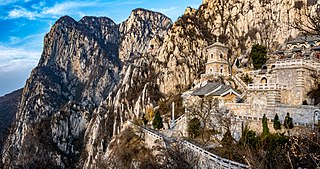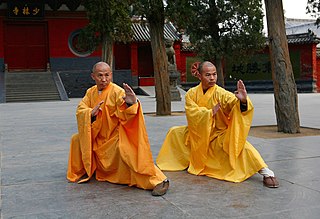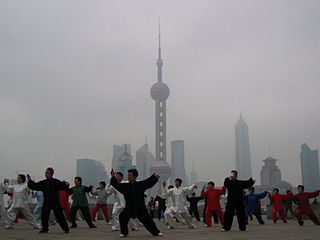
Shaolin Monastery, also known as Shaolin Temple, is a renowned temple recognized as the birthplace of Chan Buddhism and the cradle of Shaolin Kung Fu. It is located at the foot of Wuru Peak of the Songshan mountain range in Dengfeng County, Henan Province, China. The name reflects its location in the ancient grove of Mount Shaoshi, in the hinterland of the Songshan mountains. Mount Song occupied a prominent position among Chinese sacred mountains as early as the 1st century BC, when it was proclaimed one of the Five Holy Peaks. It is located some thirty miles southeast of Luoyang, the former capital of the Northern Wei Dynasty (386–534), and forty-five miles southwest of Zhengzhou, the modern capital of Henan Province.
Wu-Tang Clan is an American hip-hop group.

Shaolin Kung Fu, also called Shaolin Wushu, or Shaolin quan, is one of the oldest, largest, and most famous styles of wushu, or kung fu of Chan Buddhism. It combines Ch'an philosophy and martial arts and originated and was developed in the Shaolin temple in Henan province, Greater China during its 1500-year history. Popular sayings in Chinese folklore related to this practice include "All martial arts under heaven originated from Shaolin" and "Shaolin kung fu is the best under heaven," indicating the influence of Shaolin kung fu among martial arts. The name Shaolin is also used as a brand for the so-called external styles of kung fu. Many styles in southern and northern China use the name Shaolin.
The Venerable Chi Sim Sim Si is a legendary Chinese martial artist, is said to have been one of the Five Elders, survivors of the destruction of the Shaolin Temple by the Qing Dynasty (1644–1912). He is linked to many southern Chinese martial arts including the five major family styles of Hung, Lau and Choy gar, Lee gar and Mok gar, Ng Ga Kuen/Ng Gar King and Wing Chun.

Mount Song is a mountain in central China's Henan Province, along the southern bank of the Yellow River, that is known as the central mountain of the Five Great Mountains of China. Its summit is 1,500 metres (4,900 ft) above sea level.

The 36th Chamber of Shaolin, also known as The Master Killer, Shaolin Master Killer and Shao Lin San Shi Liu Fang, is a 1978 Hong Kong kung fu film directed by Lau Kar-leung and produced by Shaw Brothers, starring Gordon Liu. The film follows a highly fictionalized version of San Te, a legendary Shaolin martial arts disciple who trained under the general Chi Shan.

In its broadest sense, Northern Shaolin refers to the external martial arts of Northern China referring to those styles from the Northern Shaolin Monastery in Henan, and specifically to the style practice by Gù Rǔzhāng the Sōngshān Shí Lù Shàolínquán (嵩山十路少林拳) / Song Mountain Ten Road Shaolin Boxing.
In Southern Chinese folklore, the Five Elders of Shaolin, also known as the Five Generals are the survivors of one of the destructions of the Shaolin temple by the Qing Dynasty, variously said to have taken place in 1647 or in 1732.
Shaolin Monastery or Shaolin Temple is a Buddhist monastery in Henan province, China.

There are hundreds of different styles of Chinese martial arts, each with their own sets of techniques and ideas. The various movements in kung fu, most of which are imitations of the fighting styles of animals, are initiated from one to five basic foot positions: normal upright posture and the four stances called dragon, frog, horse riding, and snake. The concept of martial arts styles appeared from around the Ming dynasty (1368–1644). Before the Ming period, martial skills were commonly differentiated mainly by their lineage. There are common themes among these styles which allow them to be grouped according to generalized "families", "fractions", "class", or "schools" of martial art styles. There are styles that mimic movements from animals, or otherwise refer or allude to animals or mythical beings such as dragons, and others that gather inspiration from various Chinese philosophies or mythologies. Some deeply internal styles tend to focus strongly on practice relating to harnessing of qi energy, while some more-conspicuously external styles tend more to display skills and abilities in competition or exhibition.

Lam Sai-wing was a Hung Gar martial artist. He was a student of the Chinese martial artist, acupuncturer and folk hero of Cantonese ethnicity, Wong Fei-hung.
Shi Yongxin is the current abbot of the Shaolin Temple. He is the thirteenth successor after Shi Xingzheng. He is the Chairman of the Henan Province Buddhists Association, a representative of the Ninth National People's Congress and also one of the first Chinese monks ever to get an MBA degree.

Dengfeng is a county-level city of Henan Province, South Central China, it is under the administration of the prefecture-level city of Zhengzhou. In ancient times, it was known as Yangcheng.
The Shaolin Sect is a fictional martial arts sect mentioned in several works of wuxia fiction. It is one of the largest and best known orthodox sects in the wulin. Its base is in Shaolin Monastery, Henan, China. It is also sometimes referred to as "Shaolin Monastery" or "Shaolin Temple" instead of "Shaolin Sect".
The Wudang Sect, sometimes also referred to as the Wu-tang Sect or Wu-Tang Clan, is a fictional martial arts sect mentioned in several works of wuxia fiction. It is commonly featured as one of the leading orthodox sects in the wulin. It is named after the place it is based, the Wudang Mountains.
Ng Mui (Chinese: t 伍枚, p Wú Méi; Cantonese: Ng5 Mui4) is said to have been one of the legendary Five Elders—survivors of the destruction of the Shaolin Temple by the Qing Dynasty.
The Southern Shaolin Monastery or Nan-Shaolin (南少林) is the name of a Buddhist monastery whose existence and location are both disputed although associated ruins have been identified. By tradition, it is considered a source of Nanquan.

Shi De Yang, born Shi Wanfeng is a Chinese Buddhist priest said to be the 31st Grand Master of the fighting monks of the Shaolin Monastery. Shi De Yang is globally considered one of the greatest present exponents of traditional Shaolin culture.

Wang Bo is a martial artist, Zen Buddhist monk, Shaolin Kung Fu master, and Shifu of the Shaolin Temple Torrance, located in Torrance, CA, a main branch of the original Shaolin Temple of China. He is the founder of Hungrymonk Yoga.









